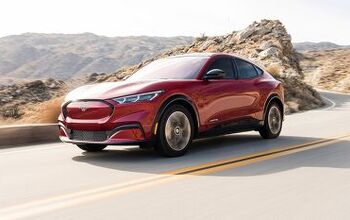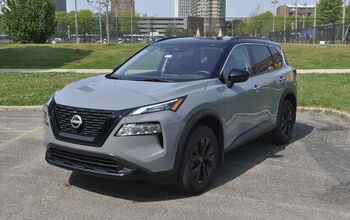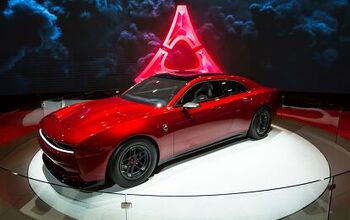Scion XD Scores Last In Euro NCAP Compact Crash Test
The Scion xD is known in Europe as the “Urban Cruiser,” and with an AWD option it’s sold as a quasi-SUV. According to a Euro NCAP crash test of comact cars though, the Urban Cruiser offers a lot less safety than you might expect in an SUV. NCAP’s latest round of compact testing saw vehicles from the new Opel Astra and Chevy Cruze to the Peugeot 308 and Mazda3 recording perfect five-star scores, indicating just how safe compact cars have become. And even the video of the Urban Cruiser’s three-star performance lacks the drama of earlier compact crash tests: a failure of side airbags and a weak performance in the new side pole crash caused the poor score. Most embarrassing of all, the Chevrolet Spark (neé Daewoo Matiz Creative) came in second to last, scoring four stars to the Urban Cruiser’s three.
Toyota’s PR has responded to the poor showing, telling What Car?:
In 2009, we received a five-star rating for all three new cars that were evaluated by Euro NCAP (iQ, Avensis and Prius).
We are therefore very surprised that the Urban Cruiser received only a three-star rating from Euro NCAP. As with any other Toyota vehicle, we had submitted the Urban Cruiser to rigorous in-house tests, which indicated that it would secure a five-star rating.
We are currently investigating the Euro NCAP result in detail, in order to understand why there is a difference between our Toyota assessment and Euro NCAP’s rating.
Together with other car makers, we are also discussing with Euro NCAP certain aspects of their evaluation methodology, which might also explain why the rating is lower than we expected.
The three-star rating for the Urban Cruiser has been triggered by the “pole side impact” test. During this assessment, the dummy head area deceleration slightly exceeded the demand value of Euro NCAP.
There is a difference of opinion between us and Euro NCAP on a technical matter, namely peak acceleration of the head area in the Pole Side Impact test.
Our in-house tests, which are designed to meet the highest safety requirements, indicated that the protection provided by the head curtain airbag would be in line with a five-star Euro NCAP rating.
Once again, we remain fully convinced that Urban Cruiser is a safe car.
And compared to past performances in this class, the xD is a relatively safe car. It’s just less safe than… a 1.2 liter Korean minicar. Deal with it, Toyota.
More by Edward Niedermeyer
Latest Car Reviews
Read moreLatest Product Reviews
Read moreRecent Comments
- Parkave231 Should have changed it to the Polonia!
- Analoggrotto Junior Soprano lol
- GrumpyOldMan The "Junior" name was good enough for the German DKW in 1959-1963:https://en.wikipedia.org/wiki/DKW_Junior
- Philip I love seeing these stories regarding concepts that I have vague memories of from collector magazines, books, etc (usually by the esteemed Richard Langworth who I credit for most of my car history knowledge!!!). On a tangent here, I remember reading Lee Iacocca's autobiography in the late 1980s, and being impressed, though on a second reading, my older and self realized why Henry Ford II must have found him irritating. He took credit for and boasted about everything successful being his alone, and sidestepped anything that was unsuccessful. Although a very interesting about some of the history of the US car industry from the 1950s through the 1980s, one needs to remind oneself of the subjective recounting in this book. Iacocca mentioned Henry II's motto "Never complain; never explain" which is basically the M.O. of the Royal Family, so few heard his side of the story. I first began to question Iacocca's rationale when he calls himself "The Father of the Mustang". He even said how so many people have taken credit for the Mustang that he would hate to be seen in public with the mother. To me, much of the Mustang's success needs to be credited to the DESIGNER Joe Oros. If the car did not have that iconic appearance, it wouldn't have become an icon. Of course accounting (making it affordable), marketing (identifying and understanding the car's market) and engineering (building a car from a Falcon base to meet the cost and marketing goals) were also instrumental, as well as Iacocca's leadership....but truth be told, I don't give him much credit at all. If he did it all, it would have looked as dowdy as a 1980s K-car. He simply did not grasp car style and design like a Bill Mitchell or John Delorean at GM. Hell, in the same book he claims credit for the Brougham era four-door Thunderbird with landau bars (ugh) and putting a "Rolls-Royce grille" on the Continental Mark III. Interesting ideas, but made the cars look chintzy, old-fashioned and pretentious. Dean Martin found them cool as "Matt Helm" in the late 1960s, but he was already well into middle age by then. It's hard not to laugh at these cartoon vehicles.
- Dwford The real crime is not bringing this EV to the US (along with the Jeep Avenger EV)

































Comments
Join the conversation
Maybe the difference in results of the in-house Toyota crash test and the NCAP test is due to an incompatible floor mat causing the car to accelerate into the pole?
Wait... the Spark passed? The Spark... actually... passed? The car that formerly got zero stars (improved to two) on the EuroNCAP test now gets four? Funny... Hell doesn't seem to have frozen over... it's not raining frogs... and I haven't mysteriously grown a second head overnight... GM has finally engineered a small car... not just cobbled it together... Still wouldn't buy one.